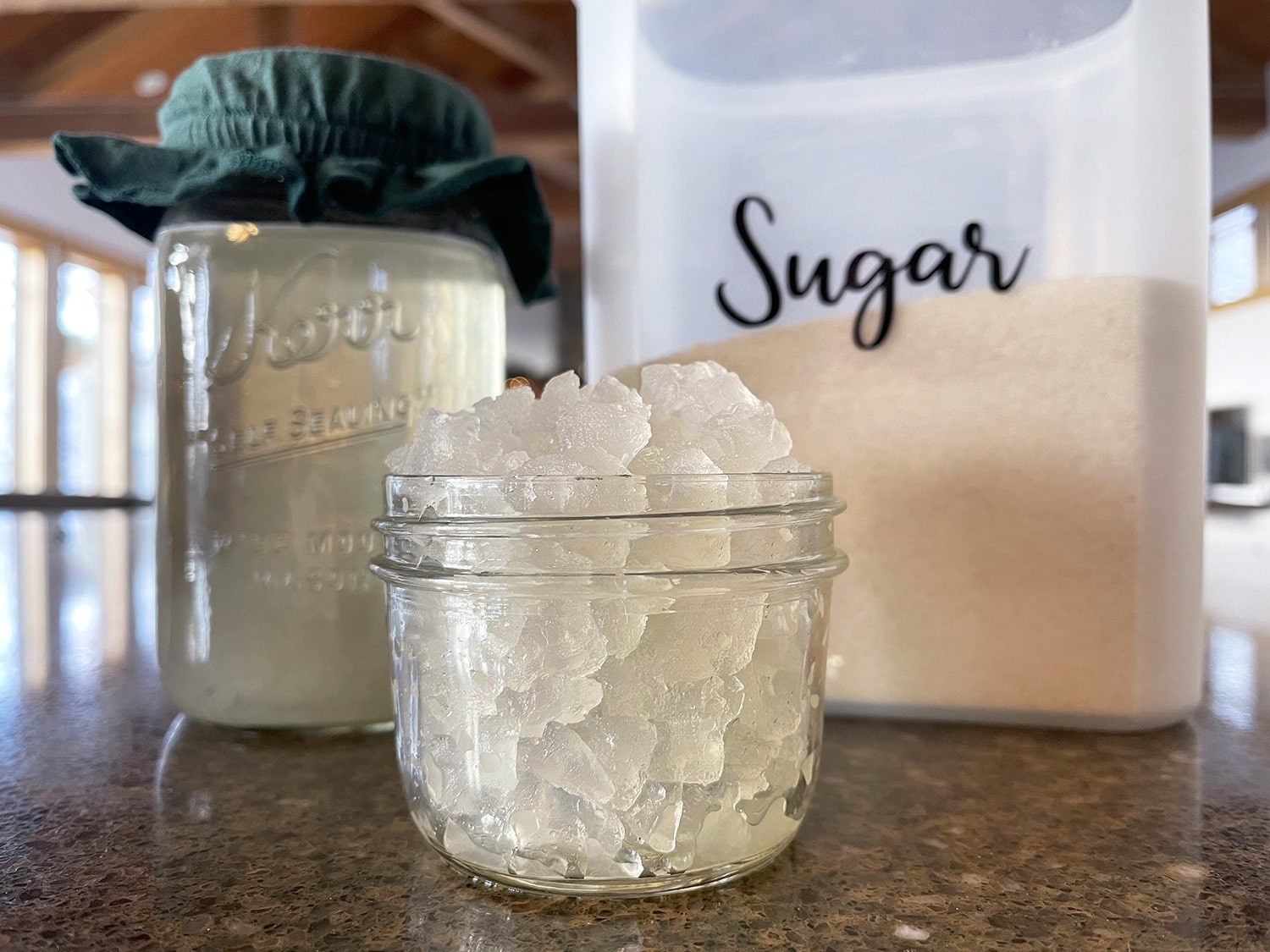Inspired by the Wise Traditions conference we attended in October, I have (re)committed to serving a bit of fermented food or drink with every meal.
No more excuses — it’s just too important!
One of our favorite and most convenient ways to get real-food probiotics is with homemade water kefir (pronounced kuh-feer) — a delicious, probiotic-rich beverage made by fermenting sugar water with a symbiotic culture of bacteria and yeast.
Water kefir vs kombucha
I love me some kombucha and there’s a big vat of continuous-brew booch in my kitchen, but I tend to favor water kefir for a few reasons:
Water kefir is caffeine free. My kombucha is usually made with green tea, so it may not be the best choice for later in the day.
You get more immediate gratification. Even with the second ferment step, water kefir is faster to make from start to finish.
Water kefir produces a milder-tasting, less acidic beverage than kombucha, which can be quite tart and vinegary depending on how long it’s brewed. Kefir kinda tastes like soda, so for those unaccustomed to the (admittedly acquired) taste of kombucha, water kefir is probably the most palatable introduction to the world of probiotic beverages.
I’ve seen some sources suggest that water kefir may not be as potent as kombucha in the probiotic department; however, it’s not really an apples to apples comparison, since the microbes that make up water kefir grains are quite different from the ones in a kombucha SCOBY.
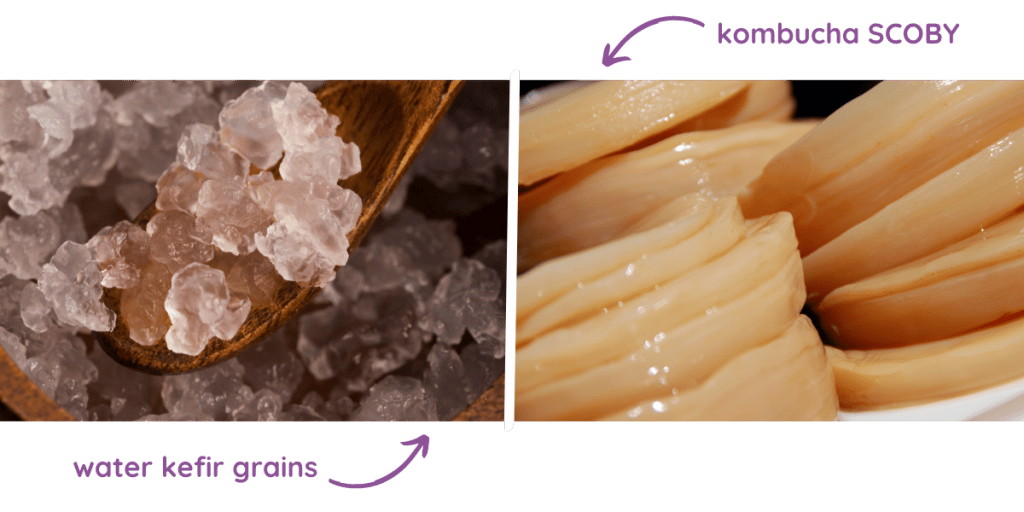
Water kefir grains, aka “tibicos,” are a multi-species starter culture of bacteria and yeast related to the kombucha SCOBY. They might be related, but they couldn’t look more different, since water kefir contains more bacterial cultures, while kombucha tends to be heavier on the yeasts.
Generally, water kefir is composed mainly of varying proportions of the bacterial species: Lactobacillus, Leuconostoc, Acetobacter, Gluconobacter and Bifidobacterium.
The microbial composition of kombucha, on the other hand, varies from SCOBY to SCOBY but generally may include more yeast strains like Saccharomyces, Acetobacter, Pediococcus, Gluconacetobacter and Brettanomyces.
Both beverages contain a variety of organic acids (lactic, acetic), vitamins, polyphenols, amino acids and antioxidants, so it probably doesn’t matter much which one you drink. I’d say the one you and your family enjoy is the “best” choice!
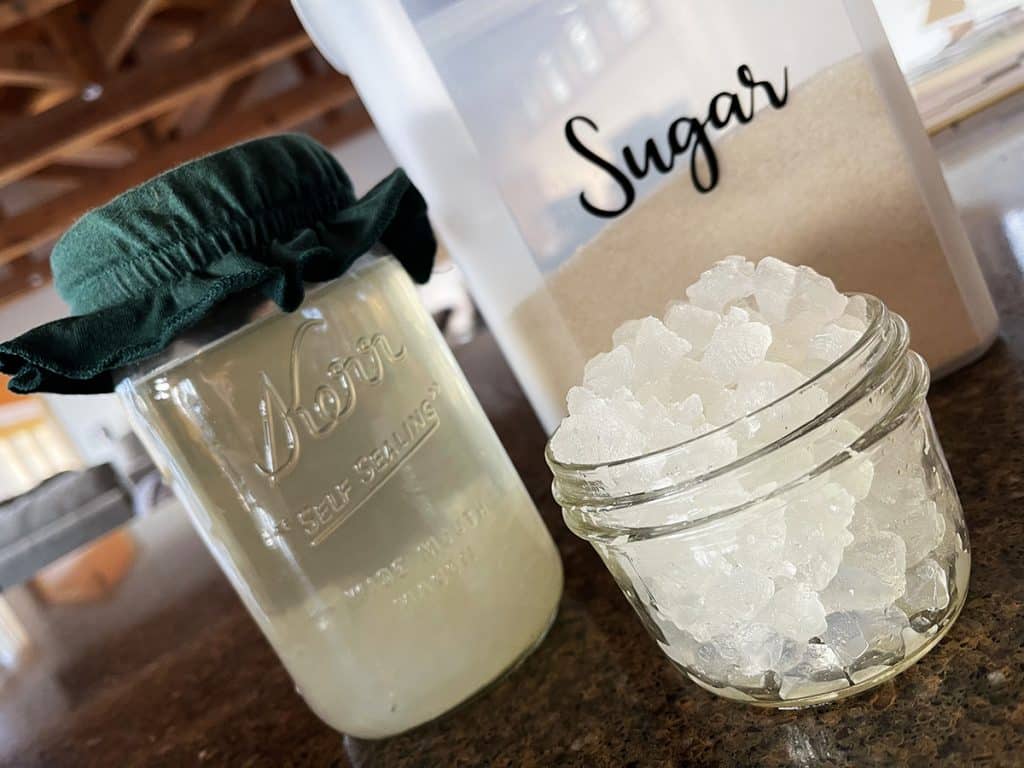
Making water kefir
The fermentation process that converts the sugar water into a fizzy, mildly sweet & sour probiotic beverage is a simple process that only requires a few ingredients and some basic, inexpensive equipment. To get started, you will need:
- hydrated water kefir grains (bum some off a friend or order from an online source such as Cultures for Health)
- filtered, non-chlorinated water
- organic sugar (cane, turbinado or brown sugars will all work)
- a glass jar
- cheesecloth, muslin or other breathable cloth cover
- a rubber band to secure the cover
- airtight lid (for second ferment)
After the initial ferment, you can choose to drink your water kefir plain OR you can customize it with juice, fruit, herbs and spices. This optional step is known as the ‘second ferment’ and it’s necessary if you want your kefir to be carbonated.
Essentially all you’re doing with the second ferment is adding a bit more sugar in the form of fruit or fruit juice, so the kefir can use it to carry on fermenting a bit longer. But this time, instead of a cloth cover, you’ll cover the jar tightly so the carbonation can build instead of dissipating into the atmosphere.
The second ferment is where your creativity can really run wild. Experiment and come up with your own unique flavor combinations. A general guideline I like to use for easy flavor combos is one fruit + 1 herb:
- strawberry + basil
- blueberry/huckleberry + mint
- lemon + ginger
- pineapple + coconut
- pineapple + ginger
- lemon + pineappleweed
- orange + cardamom
- mango + ginger
- raspberry/thimbleberry + vanilla
- peach + cinnamon
- blackberry + lavender
- cherry limeade
…you get the idea!
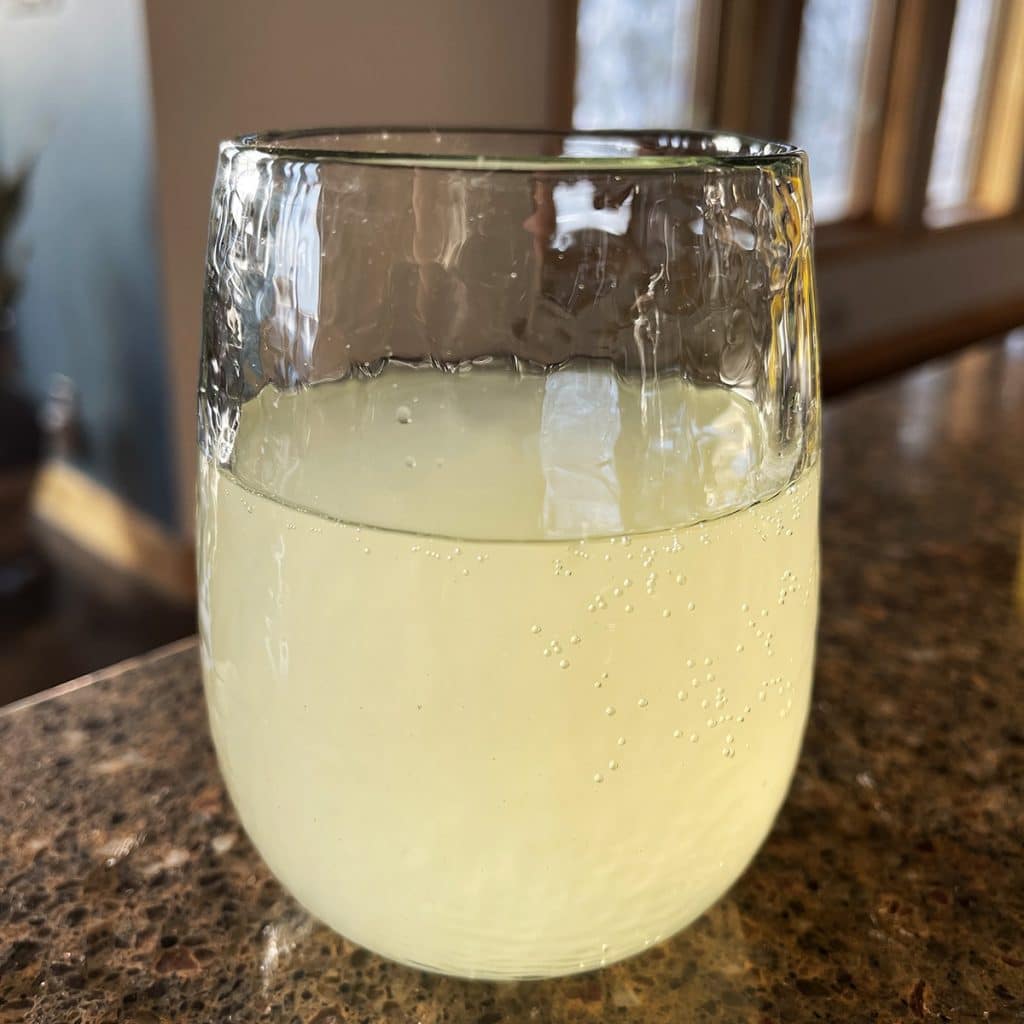
You can also use fruit juices. Our current favorite second ferment flavors are Lakewood Organic Pineapple-Ginger or Orange-Mango plus a bit of grated ginger. The orange-mango produces a something that’s almost a perfect copycat of GT’s Aqua Kefir orange-peach-mango flavor. It’s delish!
After 24-48 hours, check the second ferment for flavor, sweetness level and fizziness. If it’s not to your liking, you can ferment it for an additional 12-24 hours. Do keep an eye on your second ferment so it doesn’t build up *too* much pressure, or you might end up with fruit and kefir on your ceiling (ask me how I know this!)
I like using these silicone sealing lid inserts with the jar’s metal ring in place of the the regular metal lid. The silicone disc can expand quite a bit and is a forgiving cover if you get distracted and forget to burp your jar often enough:
Managing a rotating supply of water kefir
It’s true that the kefir does need to be tended to every couple of days, but once you get a system down, it’s super fast and easy.
Strain the kefir into a new clean jar and set it and the grains aside… In a new clean jar, add sugar and enough hot water to dissolve the sugar (from the tap if you have a good filter)… Swirl the jar a bit until the sugar is mostly dissolved, then fill the jar halfway full with cold water… Add the grains to the tepid sugar-water, top up with additional cool water and cover with your breathable cap… To do start your second ferment, add 1/4 c of fruit and/or juice to your strained kefir and cover with an airtight lid…
…and boom, you’re done.
This takes me less than 2 minutes from start to finish. Even less if I’m just using juice for the second ferment.
As with most things, the right tools make the job a bit easier. For example, I really like these stainless strainer tubes* that are sold for making cold brew coffee. They fit any wide-mouth mason jar, and hold a lot of kefir grains. When I strain my kefir into a new jar for the second ferment, the grains can just hang out in the tube while I prepare the sugar water solution.
Easy peasy!
* I’ve seen quite a few Internet sources warning against using metal tools around your kefir grains, but I’ve never personally had a problem with my stainless filter. Cultures for Health clarifies that a stainless steel strainer can be used, but avoid other metals, which may react with and damage the grains.
There you go.
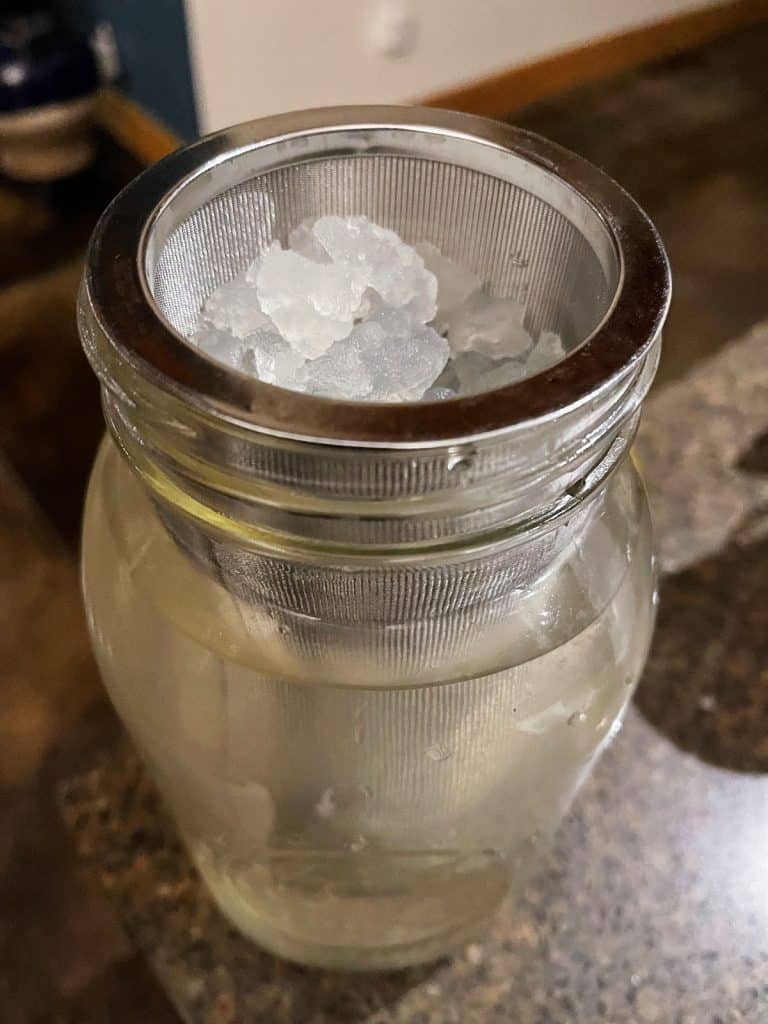
Too much of a good thing?
Once you obtain an initial set of water kefir grains, your biggest problem will be how to keep up with the volume of grains that increase with each batch. They multiply like rabbits, I tell ya! Within a month of starting up water kefir again, I had a half-gallon jar that was nearly full of beautiful clear kefir grains.
It’s not a bad idea to keep a reserve jar of kefir grains in the refrigerator in case something goes wrong with your active grains. To make a kefir “hotel” simply make a batch of sugar water as though you were going to start a new ferment. Add your extra grains to the solution and cover with an airtight lid. Replace the kefir hotel’s sugar water every 2 weeks or so. Your grains will keep in the refrigerator this way indefinitely.
To reactivate your hibernating kefir grains, simply make a new batch of sugar water and let them revive on the counter for a few days. Strain out the grains and discard this batch of water kefir. Your grains should be ready to rock again.
Share the love (and knowledge)
Why not hook up all of your friends and family with your excess water kefir grains and teach them how to make their own water kefir!
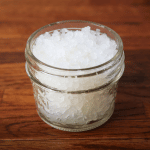
Basic Water Kefir
5 Stars 4 Stars 3 Stars 2 Stars 1 Star
No reviews
Ingredients
1/4–1/3 c water kefir grains
1/4 c sugar
1 quart filtered, non-chlorinated water
Instructions
- In a 1-quart mason jar, combine the sugar with about 1/2-cup hot water, stirring until sugar is completely dissolved.
- Fill jar to about the halfway point with cold water to bring down the temperature (you want it no warmer than 85F) before adding your water kefir grains.
- Add 1/4 c kefir grains and top up with more cool water.
- Cover jar with a coffee filter or other tightly-woven cloth and secure with a rubber band.
- Allow to ferment at room temperature for 24-48 hours. It may take a bit longer if your house is on the colder side.
- When your water kefir is finished fermenting, strain out the grains using a fine mesh strainer over a second glass mason jar.
- Prepare a new batch of sugar water as described in steps 1 and 2 and add your grains to keep the fermenting process going. (This way, you can have a new batch of water kefir ready to drink every 3-4 days, depending on how long you let it culture.)
- You can drink the plain kefir as is, OR you can do a second ferment to add flavor and carbonation. To do a second ferment, simply add about 1/4 c of mashed fruit, grated ginger or fruit juice to your kefir and cover with an air-tight lid. Allow the kefir to ferment an additional day or two, keeping an eye on it so it doesn’t build up too much pressure. When it tastes the way you like it, call it ‘done’ and transfer to the refrigerator.
Notes
This recipe can easily be doubled to fill a 2-quart jar.

